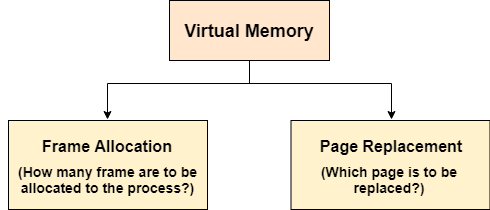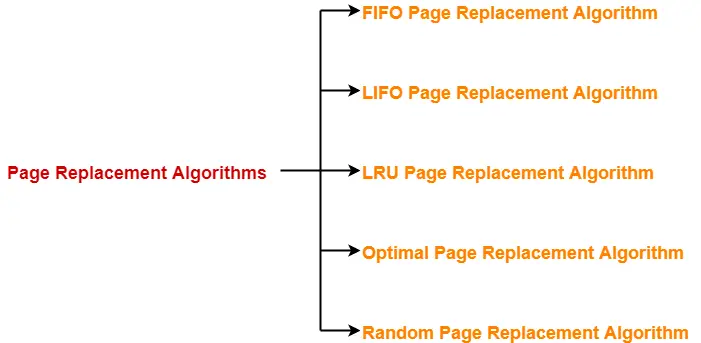Page replacement algorithm in OS
Page Replacement Algorithms


The page replacement algorithm decides which memory page is to be replaced. The process of replacement is sometimes called swap out or write to disk. Page replacement is done when the requested page is not found in the main memory (page fault).

There are two main aspects of virtual memory, Frame allocation and Page Replacement. It is very important to have the optimal frame allocation and page replacement algorithm. Frame allocation is all about how many frames are to be allocated to the process while the page replacement is all about determining the page number which needs to be replaced in order to make space for the requested page.
Types of Page Replacement Algorithms:-
Various page replacement algorithms are-

- FIFO Page Replacement Algorithm
- MRU page Replacement Algorithm
- LRU Page Replacement Algorithm
- Optimal Page Replacement Algorithm
First In First Out (FIFO) –
This is the simplest page replacement algorithm. In this algorithm, the operating system keeps track of all pages in the memory in a queue, the oldest page is in the front of the queue is removed first . When a page needs to be replaced page in the front of the queue is selected for removal.
Example-1Consider page reference string 1, 3, 0, 3, 5, 6 with 3 page frames.Find number of page faults.
Initially all slots are empty, so when 1, 3, 0 came they are allocated to the empty slots —> 3 Page Faults.
when 3 comes, it is already in memory so —> 0 Page Faults.
Then 5 comes, it is not available in memory so it replaces the oldest page slot i.e 1. —>1 Page Fault.
6 comes, it is also not available in memory so it replaces the oldest page slot i.e 3 —>1 Page Fault.
Finally when 3 come it is not avilable so it replaces 0 1 page fault.
Initially all slots are empty, so when 1, 3, 0 came they are allocated to the empty slots —> 3 Page Faults.
when 3 comes, it is already in memory so —> 0 Page Faults.
Then 5 comes, it is not available in memory so it replaces the oldest page slot i.e 1. —>1 Page Fault.
6 comes, it is also not available in memory so it replaces the oldest page slot i.e 3 —>1 Page Fault.
Finally when 3 come it is not avilable so it replaces 0 1 page fault.
Belady's anomaly :-
- Belady’s anomaly proves that it is possible to have more page faults when increasing the number of page frames while using the First in First Out (FIFO) page replacement algorithm. For example, if we consider reference string 3, 2, 1, 0, 3, 2, 4, 3, 2, 1, 0, 4 and 3 slots, we get 9 total page faults, but if we increase slots to 4, we get 10 page faults.
- Optimal Page replacement –
In this algorithm, pages are replaced which would not be used for the longest duration of time in the future.Example-2:Consider the page references 7, 0, 1, 2, 0, 3, 0, 4, 2, 3, 0, 3, 2, with 4 page frame. Find number of page fault.
Initially all slots are empty, so when 7 0 1 2 are allocated to the empty slots —> 4 Page faults
0 is already there so —> 0 Page fault.
when 3 came it will take the place of 7 because it is not used for the longest duration of time in the future.—>1 Page fault.
0 is already there so —> 0 Page fault..
4 will takes place of 1 —> 1 Page Fault.
Now for the further page reference string —> 0 Page fault because they are already available in the memory.Optimal page replacement is perfect, but not possible in practice as the operating system cannot know future requests. The use of Optimal Page replacement is to set up a benchmark so that other replacement algorithms can be analyzed against it. - Least Recently Used –
In this algorithm page will be replaced which is least recently used.Example-3Consider the page reference string 7, 0, 1, 2, 0, 3, 0, 4, 2, 3, 0, 3, 2 with 4 page frames.Find number of page faults.
Initially all slots are empty, so when 7 0 1 2 are allocated to the empty slots —> 4 Page faults
0 is already their so —> 0 Page fault.
when 3 came it will take the place of 7 because it is least recently used —>1 Page fault
0 is already in memory so —> 0 Page fault.
4 will takes place of 1 —> 1 Page Fault
Now for the further page reference string —> 0 Page fault because they are already available in the memory.
Most recently used :-
In this algorithm page will be replaced which are most recently used.
In the same example of LRU you can understand this algorithm.
Thank you viewers ..
For more information about page replacement algorithm pls follow us ..
This is contributed by soumy Sinha .




Comments
Post a Comment